Complete guide to audience segmentation
The value of customer segmentation can lend to everything from decreasing CAC to increasing customer loyalty all while building better, more personalized customer experiences. In our comprehensive guide, we break down what customer segmentation is, the business value, and the different ways you can automate segmentation using Intempt.
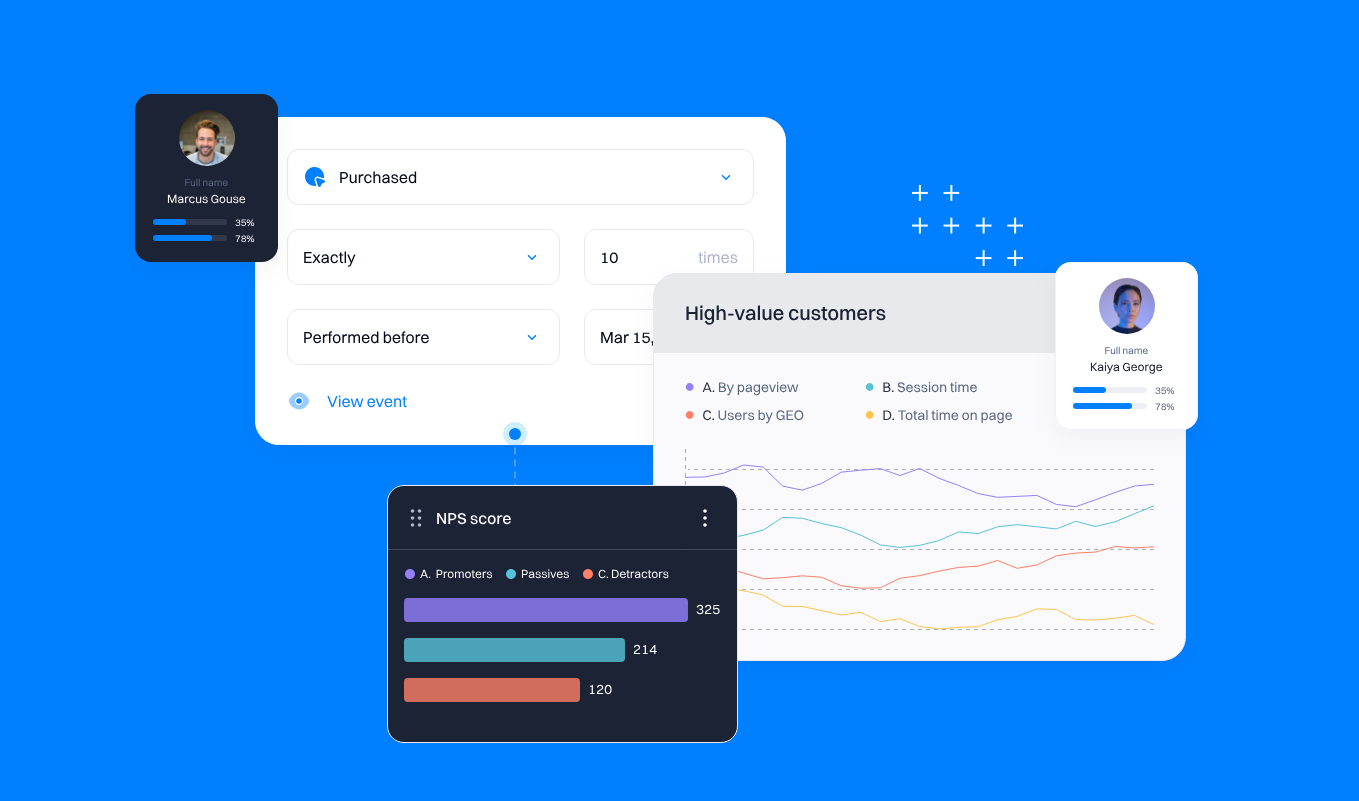
What is audience segmentation?
Audience segmentation, also known as consumer or market segmentation, is the process of grouping customers in your target audience to create a more tailored marketing message. Segmentation aims to analyze the highest-value users to divide potential customers into groups based on similar characteristics.
Segmentation allows you to pick and choose who receives these messages rather than sending the same email, ad, or campaign to everyone in your database. By segmenting your audience and engaging a specific subset of customers, your business can serve customers with more targeted, personalized content. This can increase customer conversions and improve the ROI of your marketing and advertising efforts.
By using customer segmentation, you can:
- Identify the best customers and focus on offering them the best treatment;
- Improve product assortment based on your top customers’ preferences;
- Create better communication, offers, loyalty programs, experiences, and products for your power customers;
- Increase customer engagement by leveraging the best-performing channels;
- Improve and prioritize the customer service team’s activity
- Target leads & accounts
- Create lookalike audiences based on your top customers and improve the results of acquisition campaigns.
- Identifying the best customer segmentation model for your business is one of the most important steps you can take for the healthy development of your company
Types of audience segmentation
Common customer segmentation models have different approach ranges between simple and complex. 7 of the most important segmentation types will be included here:
Demographic segmentation
Segmenting on the specific user's attributes to create a meaningful grouping for a cohort. Gender is usually identified to create and deliver content specifically on that segment. Parental status is also important. It can be derived directly from purchase details or by intentionally asking for more information from customers.
Firmographic segmentation
Company-related data that define their target market, including industry, number of employees, legal status, company size, financial standing, and other business-related variables.
Behavioral segmentation
Past behaviors that indicate how to group the customer based on the frequency and recency of the action (e.g., last purchase made, number of daily logins, etc.)
Predictive segmentation
This segmentation type involves using ML models to anticipate customers' future actions based on their past behavior.
Fit & Activity segmentation
Segmentation that considers both firmographic and behavioral data to determine if the lead is the right fit for outreach. Mostly used for B2B SaaS use cases.
Recency, frequency, monetary (RFM segmentation)
RFM is a method used to identify and analyze customers based on the Recency of their last purchase, the Frequency of purchases, and the Monetary amount spent. This is useful for identifying your high-value and at risk customers.
The Three Levels of Segmentation
In addition to there being multiple types of segmentation, there are also different levels of segmentation, which are as follows:
Level One: Manual Segmentation
Relationships managers are responsible for maintaining personal relationships with clients and prospects. Due to the unique level of insight these relationships offer, relationship managers will often choose to manually segment customers or even provide additional context to rule- or query-driven segments.
Level Two: Rule-based Segmentation
By identifying priority segments as an organization, business leaders can establish rules that will automatically segment customers and prospects based on their relationship with the organization. This method enables the strategic development of prioritized segments to identify revenue opportunities, increase wallet share, and identify the right product for the right customer at the right time.
Level Three: Segmentation with AI/Machine Learning
Once it has established rules-based segments, an organization can take segmentation to the next level by supplementing them with artificial intelligence (AI) and machine learning (ML). Organizations that leverage AI and ML models can identify and predict a customer’s needs and next actions based on the combined history of all previous interactions with every customer and prospect. A well-executed AI/ML model will contextualize data and signals across multiple different datasets.
Good to know
Level one use cases can work in very limited scenarios - we usually suggest focusing on rule-based and AI segmentation - Intempt supports both types.
Segmentation use cases
1. Build a list of leads based on their Fit & Activity score
Another way to slice your customer data is by looking at their engagement and fit criteria. With Intempt, you can measure engagement by creating Fit & Activity scores and then setting them in the segment builder as a conditional filter.
For example, you may use the conditions for company fit:

And the lead activity criteria for contacting marketing qualified leads (MQLs).
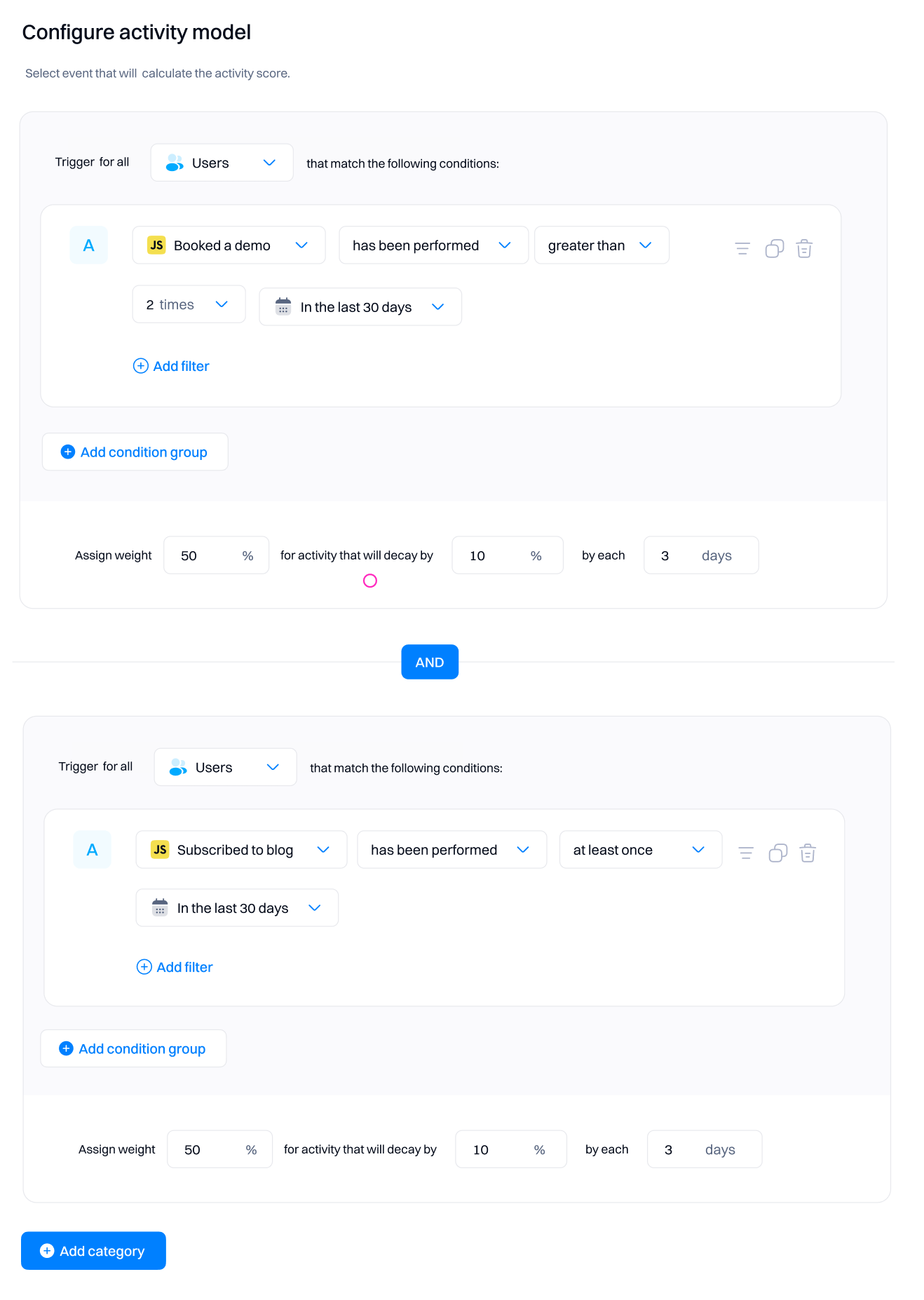
Note that the activity has a decay factor, meaning that every x days, the score for the activity will decay if the user does not perform an event.
After you create the scores, you can use them to segment the users.

2. Identify your ideal customer based on MRR/CLV
SaaS businesses can create segments based on monthly recurring revenue (MRR), and eCommerce businesses can look at customer lifetime value (CLV). Doing so means you can start identifying common attributes of your top-performing customers to develop an ‘ideal’ buyer persona.
For example, let’s say you’re a DTC-exclusive chocolate brand. You can create a segment of your best customers based on their CLV value.

You can also create a custom dashboard to track important metrics for your business. Over time, this will give you a deeper understanding of your ideal customers.
3. Create geo-based segments
Look at the geographic location and product activity when creating segments to prioritize customers depending on their location. Intempt uses autotrack and IP enrichment to automatically assign a location to any visitor, so you can can easily use it in segmentation.
This is an example user details page.
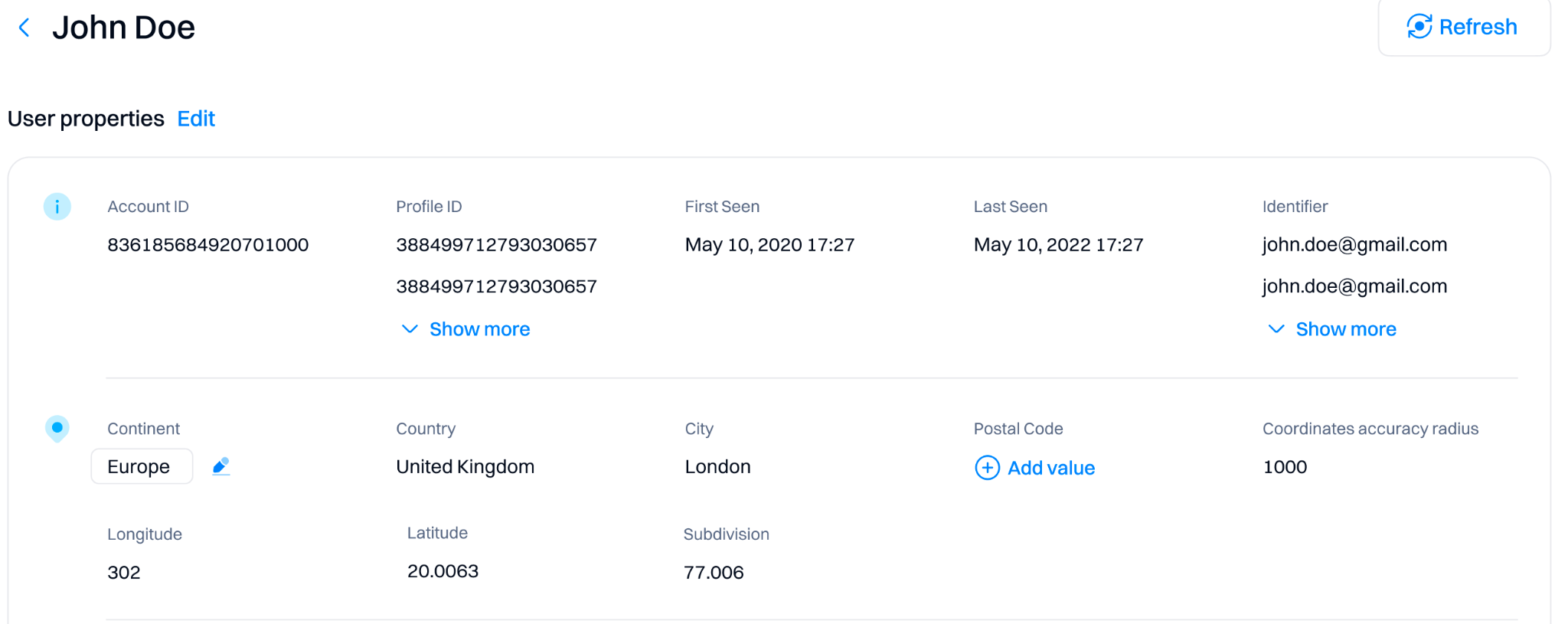
You use this geographic information to create granular segments with location filters.

4. Segment customers by buying behavior
Segmenting your customers by buying behavior is a great way to understand their purchasing habits, their relation to your brand and how you should engage them.
The easiest way to do this is to perfrom RFM segmentation. Intempt's RFM feature allows you to automatically group all of your customers based on how recently, frequently, and with what monetary value they performed the conversion event (like purchase).
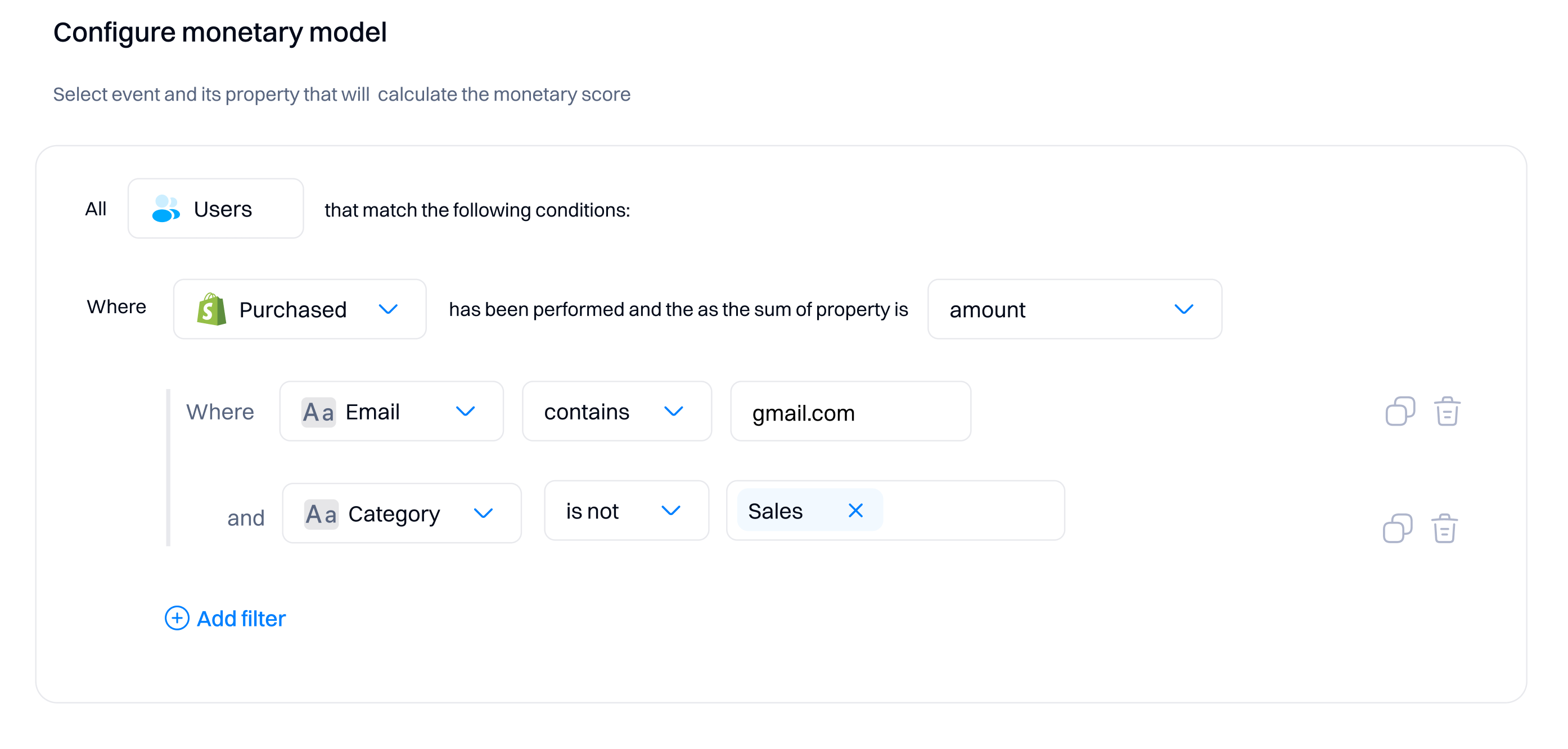
There are five types of segments users are automatically assigned to.
Champions - customers that bought recently, ordered often, and spent the most.
Regulars - Orders regularly. Responsive to promotions.
Promising - customers who regularly buy for a small amount or have recently bought for a large amount may become ideal clients in the long run. Your job is to hold their interest and increase user engagement.
Needs attention - customers who have bought many times for large sums in the past - no longer now. To get customers back, you should offer a personal selection of products, discounts, and bonuses and inform them about the sale.
At risk - Customers who made smaller and infrequent purchases before but haven't purchased anything in a long time.
By looking at the RFM segment, you can identify and capitalize on pattern changes. For example, if you know that a customer "Needs attention" (purchased from your store regularly but has dropped off the radar over the last few months), you may re-engage them using a win-back email campaign.

5. Segment by funnel stages
Segment customers by stage of the buying journey to effectively guide them down the sales funnel.
Those at the top of the funnel (prospects) should receive content that enhances brand awareness, such as blog posts, podcasts, social media posts, etc.
Middle-of-the-funnel leads are at the evaluation stage and want to see how your product and/or service fixes their problem. Therefore, you should send them educational resources, webinar or event invites, surveys or quizzes, free trials, discounts, or offers.
The bottom-of-the-funnel leads are close to converting. Send them content that will help them make an informed purchasing decision: testimonials, case studies, demos, product comparison pages, etc.
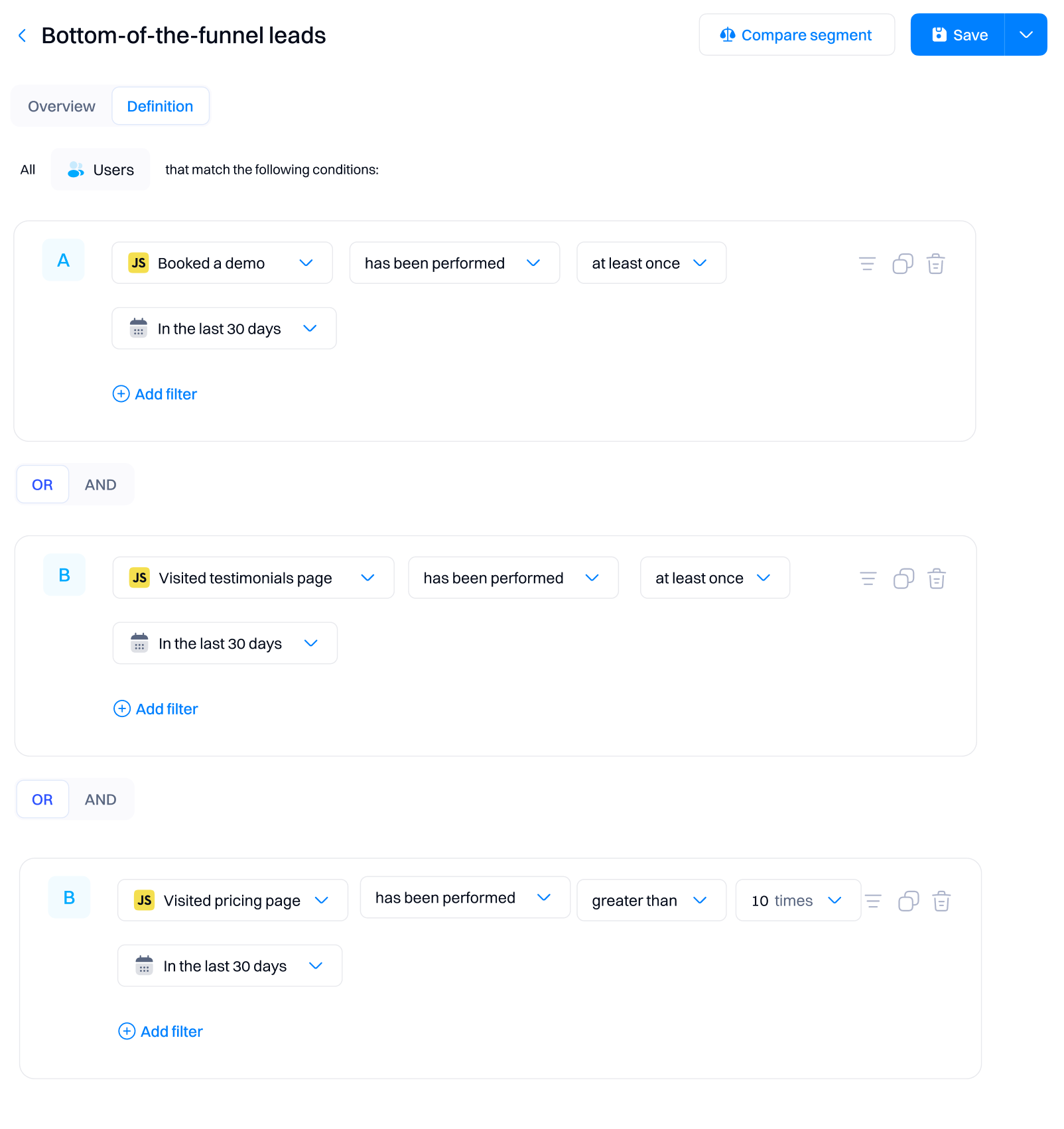
6. Segment based on the likelihood to convert
You can use an ML algorithm to determine if the user will perform the goal event (like likelihood to subscribe) and use the output attribute to create segments.
To do this, you need to define the goal event and the time window in which it should be performed.

After you create the predictive model, it will score all customers based on the inclusion criteria, bucketing them into low, medium, and high probability to perform the event.
Use the attribute to segment customers' likelihood of performing the conversion event.

Wrapping up
Properly executed segmentation allows you to group and target your audience effectively. With Intempt’s data model, you can use advanced rules-based segment builder and ML scoring capabilities to optimize your segmentation for any use case.
Updated 4 days ago